BTEC HND Unit 9: Entrepreneurship & Small Business Management Report
VerifiedAdded on 2023/01/12
|15
|4396
|66
Report
AI Summary
This report delves into the realm of entrepreneurship and small business management, offering a comprehensive analysis of various entrepreneurial ventures, including large company, scalable, social, and small business models. It explores the similarities and differences between these ventur...
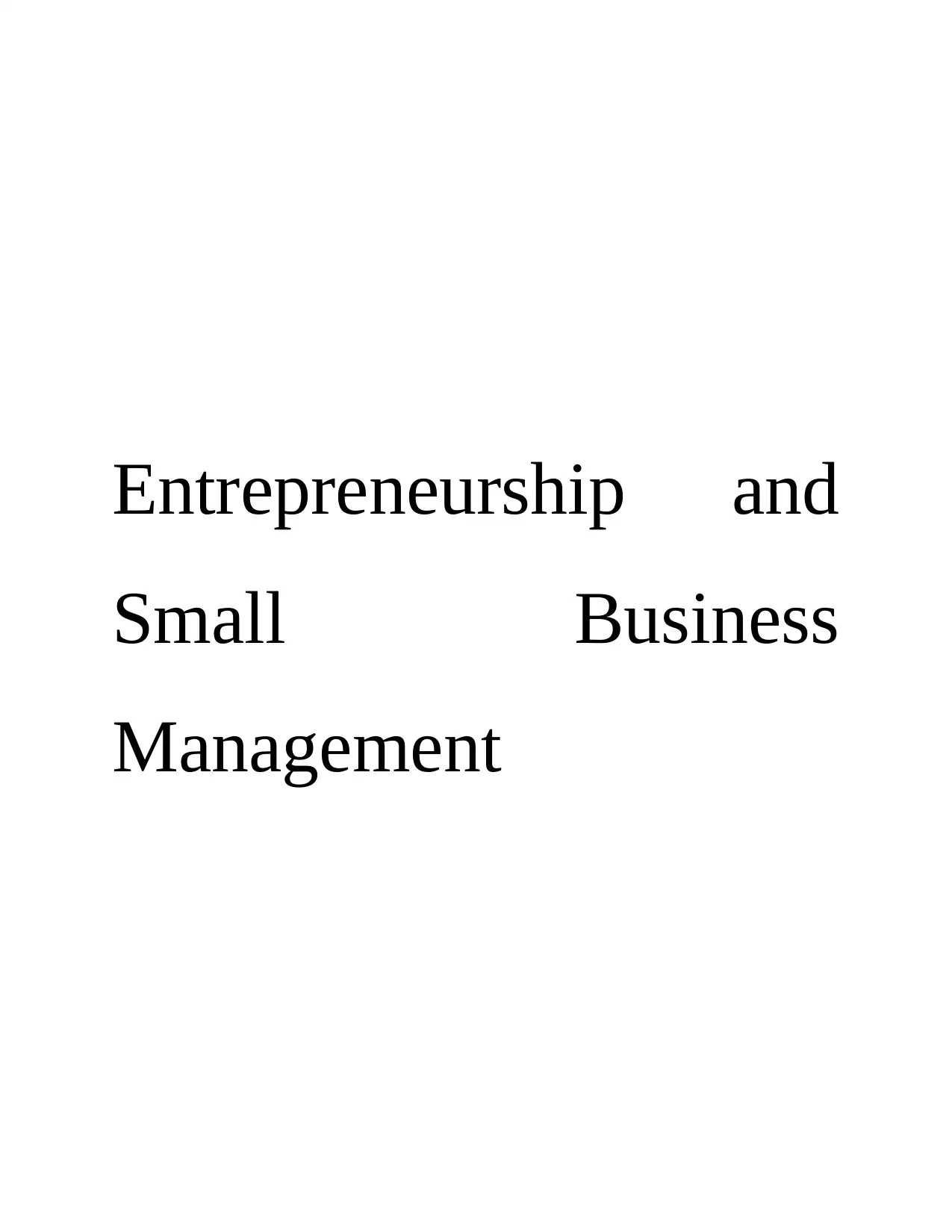
Entrepreneurship and
Small Business
Management
Small Business
Management
Paraphrase This Document
Need a fresh take? Get an instant paraphrase of this document with our AI Paraphraser
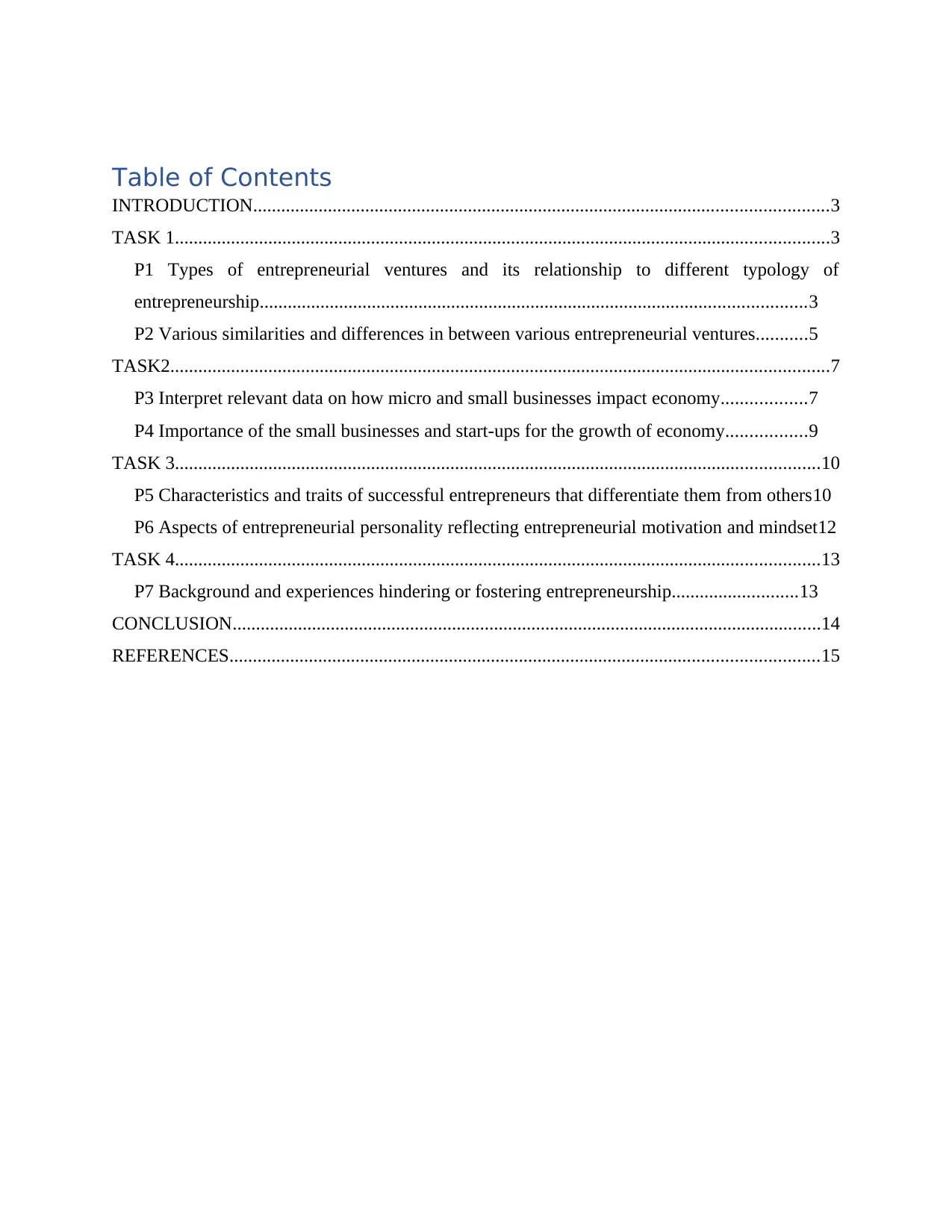
Table of Contents
INTRODUCTION...........................................................................................................................3
TASK 1............................................................................................................................................3
P1 Types of entrepreneurial ventures and its relationship to different typology of
entrepreneurship.....................................................................................................................3
P2 Various similarities and differences in between various entrepreneurial ventures...........5
TASK2.............................................................................................................................................7
P3 Interpret relevant data on how micro and small businesses impact economy..................7
P4 Importance of the small businesses and start-ups for the growth of economy.................9
TASK 3..........................................................................................................................................10
P5 Characteristics and traits of successful entrepreneurs that differentiate them from others10
P6 Aspects of entrepreneurial personality reflecting entrepreneurial motivation and mindset12
TASK 4..........................................................................................................................................13
P7 Background and experiences hindering or fostering entrepreneurship...........................13
CONCLUSION..............................................................................................................................14
REFERENCES..............................................................................................................................15
INTRODUCTION...........................................................................................................................3
TASK 1............................................................................................................................................3
P1 Types of entrepreneurial ventures and its relationship to different typology of
entrepreneurship.....................................................................................................................3
P2 Various similarities and differences in between various entrepreneurial ventures...........5
TASK2.............................................................................................................................................7
P3 Interpret relevant data on how micro and small businesses impact economy..................7
P4 Importance of the small businesses and start-ups for the growth of economy.................9
TASK 3..........................................................................................................................................10
P5 Characteristics and traits of successful entrepreneurs that differentiate them from others10
P6 Aspects of entrepreneurial personality reflecting entrepreneurial motivation and mindset12
TASK 4..........................................................................................................................................13
P7 Background and experiences hindering or fostering entrepreneurship...........................13
CONCLUSION..............................................................................................................................14
REFERENCES..............................................................................................................................15
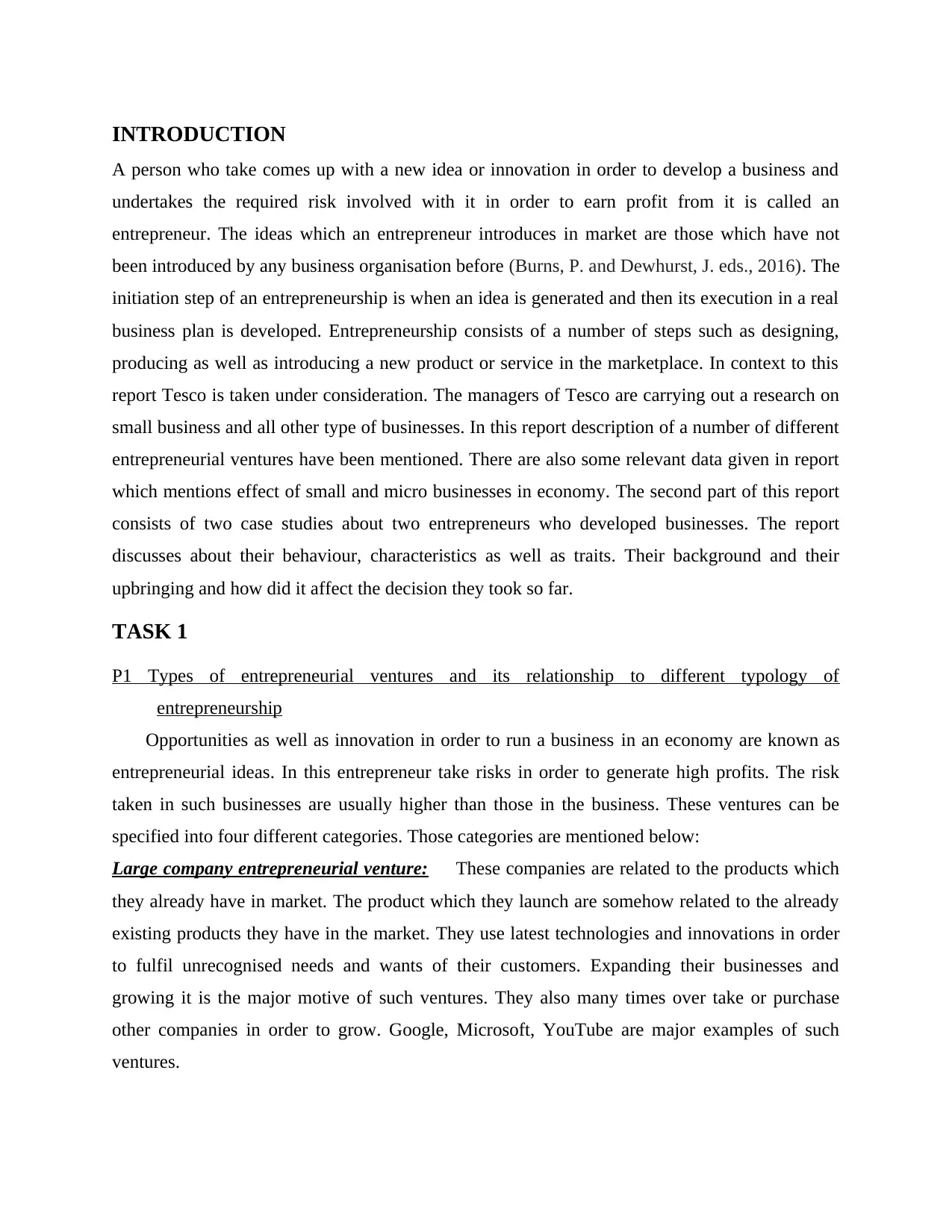
INTRODUCTION
A person who take comes up with a new idea or innovation in order to develop a business and
undertakes the required risk involved with it in order to earn profit from it is called an
entrepreneur. The ideas which an entrepreneur introduces in market are those which have not
been introduced by any business organisation before (Burns, P. and Dewhurst, J. eds., 2016). The
initiation step of an entrepreneurship is when an idea is generated and then its execution in a real
business plan is developed. Entrepreneurship consists of a number of steps such as designing,
producing as well as introducing a new product or service in the marketplace. In context to this
report Tesco is taken under consideration. The managers of Tesco are carrying out a research on
small business and all other type of businesses. In this report description of a number of different
entrepreneurial ventures have been mentioned. There are also some relevant data given in report
which mentions effect of small and micro businesses in economy. The second part of this report
consists of two case studies about two entrepreneurs who developed businesses. The report
discusses about their behaviour, characteristics as well as traits. Their background and their
upbringing and how did it affect the decision they took so far.
TASK 1
P1 Types of entrepreneurial ventures and its relationship to different typology of
entrepreneurship
Opportunities as well as innovation in order to run a business in an economy are known as
entrepreneurial ideas. In this entrepreneur take risks in order to generate high profits. The risk
taken in such businesses are usually higher than those in the business. These ventures can be
specified into four different categories. Those categories are mentioned below:
Large company entrepreneurial venture: These companies are related to the products which
they already have in market. The product which they launch are somehow related to the already
existing products they have in the market. They use latest technologies and innovations in order
to fulfil unrecognised needs and wants of their customers. Expanding their businesses and
growing it is the major motive of such ventures. They also many times over take or purchase
other companies in order to grow. Google, Microsoft, YouTube are major examples of such
ventures.
A person who take comes up with a new idea or innovation in order to develop a business and
undertakes the required risk involved with it in order to earn profit from it is called an
entrepreneur. The ideas which an entrepreneur introduces in market are those which have not
been introduced by any business organisation before (Burns, P. and Dewhurst, J. eds., 2016). The
initiation step of an entrepreneurship is when an idea is generated and then its execution in a real
business plan is developed. Entrepreneurship consists of a number of steps such as designing,
producing as well as introducing a new product or service in the marketplace. In context to this
report Tesco is taken under consideration. The managers of Tesco are carrying out a research on
small business and all other type of businesses. In this report description of a number of different
entrepreneurial ventures have been mentioned. There are also some relevant data given in report
which mentions effect of small and micro businesses in economy. The second part of this report
consists of two case studies about two entrepreneurs who developed businesses. The report
discusses about their behaviour, characteristics as well as traits. Their background and their
upbringing and how did it affect the decision they took so far.
TASK 1
P1 Types of entrepreneurial ventures and its relationship to different typology of
entrepreneurship
Opportunities as well as innovation in order to run a business in an economy are known as
entrepreneurial ideas. In this entrepreneur take risks in order to generate high profits. The risk
taken in such businesses are usually higher than those in the business. These ventures can be
specified into four different categories. Those categories are mentioned below:
Large company entrepreneurial venture: These companies are related to the products which
they already have in market. The product which they launch are somehow related to the already
existing products they have in the market. They use latest technologies and innovations in order
to fulfil unrecognised needs and wants of their customers. Expanding their businesses and
growing it is the major motive of such ventures. They also many times over take or purchase
other companies in order to grow. Google, Microsoft, YouTube are major examples of such
ventures.
⊘ This is a preview!⊘
Do you want full access?
Subscribe today to unlock all pages.

Trusted by 1+ million students worldwide

Scalable entrepreneurial venture: these ventures are the one who come in the market with a
new idea, concept, revolution in order to change the world. They aim much bigger than any other
venture in the market. There is international business is carried out by these ventures. They need
skilled and well-trained human resources for their business. They look for convenient business
models which can enormously boost their profits. Facebook, online retailing, online shopping
applications, Instagram can be said to be major examples for such ventures.
Social Entrepreneurial ventures: The products and services brought in by these ventures in the
society are usually to deal with the issues arising in market. Major motive of these enterprises
hard to bring in peace and make the world a better place to live. These include profit as well as
non-profit organisations or it can be a hybrid of both of these organisations. Safe point trust can
be an example of such venture. This organization focuses on manufacturing syringe which can
be reused. For this purpose they have collaborated with major small hospitals and clinics around
the world who cannot afford expensive treatments as well as inventories for their organization.
Till date they have been successful in manufacturing more than 4 billion syringe and have
circulated it in more than 40 countries around the world (Burns, P. and Dewhurst, J. eds., 2016).
Small business entrepreneurial ventures:There has been total 90% of such enterprises in US.
These enterprises are small ventures and they usually recruit the employs which are non-
governmental. Major motive of such organizations is to fulfil the day to day needs. The capital
required to start such a business is very low so that interest could be easily paid out of profits
which are found from such business. In order to set up such a business entrepreneur generally
seek help from their friends as well as families. Major examples for such ventures can be
carpenters, consultants, plumbers and many such more.
These ventures have successfully generated some typologies in business as well. The
typologies generated from this business have a great impact on running of the business as per the
opinion taken by entrepreneurs who run this business. Some of the major typologies are assessed
below:
Various typologies of entrepreneurial venture:
A typology can be said to be differentiating a number of things on the basis of their
structure, plan, style and many more. Major typologies in an entrepreneurial venture are
mentioned below:
new idea, concept, revolution in order to change the world. They aim much bigger than any other
venture in the market. There is international business is carried out by these ventures. They need
skilled and well-trained human resources for their business. They look for convenient business
models which can enormously boost their profits. Facebook, online retailing, online shopping
applications, Instagram can be said to be major examples for such ventures.
Social Entrepreneurial ventures: The products and services brought in by these ventures in the
society are usually to deal with the issues arising in market. Major motive of these enterprises
hard to bring in peace and make the world a better place to live. These include profit as well as
non-profit organisations or it can be a hybrid of both of these organisations. Safe point trust can
be an example of such venture. This organization focuses on manufacturing syringe which can
be reused. For this purpose they have collaborated with major small hospitals and clinics around
the world who cannot afford expensive treatments as well as inventories for their organization.
Till date they have been successful in manufacturing more than 4 billion syringe and have
circulated it in more than 40 countries around the world (Burns, P. and Dewhurst, J. eds., 2016).
Small business entrepreneurial ventures:There has been total 90% of such enterprises in US.
These enterprises are small ventures and they usually recruit the employs which are non-
governmental. Major motive of such organizations is to fulfil the day to day needs. The capital
required to start such a business is very low so that interest could be easily paid out of profits
which are found from such business. In order to set up such a business entrepreneur generally
seek help from their friends as well as families. Major examples for such ventures can be
carpenters, consultants, plumbers and many such more.
These ventures have successfully generated some typologies in business as well. The
typologies generated from this business have a great impact on running of the business as per the
opinion taken by entrepreneurs who run this business. Some of the major typologies are assessed
below:
Various typologies of entrepreneurial venture:
A typology can be said to be differentiating a number of things on the basis of their
structure, plan, style and many more. Major typologies in an entrepreneurial venture are
mentioned below:
Paraphrase This Document
Need a fresh take? Get an instant paraphrase of this document with our AI Paraphraser
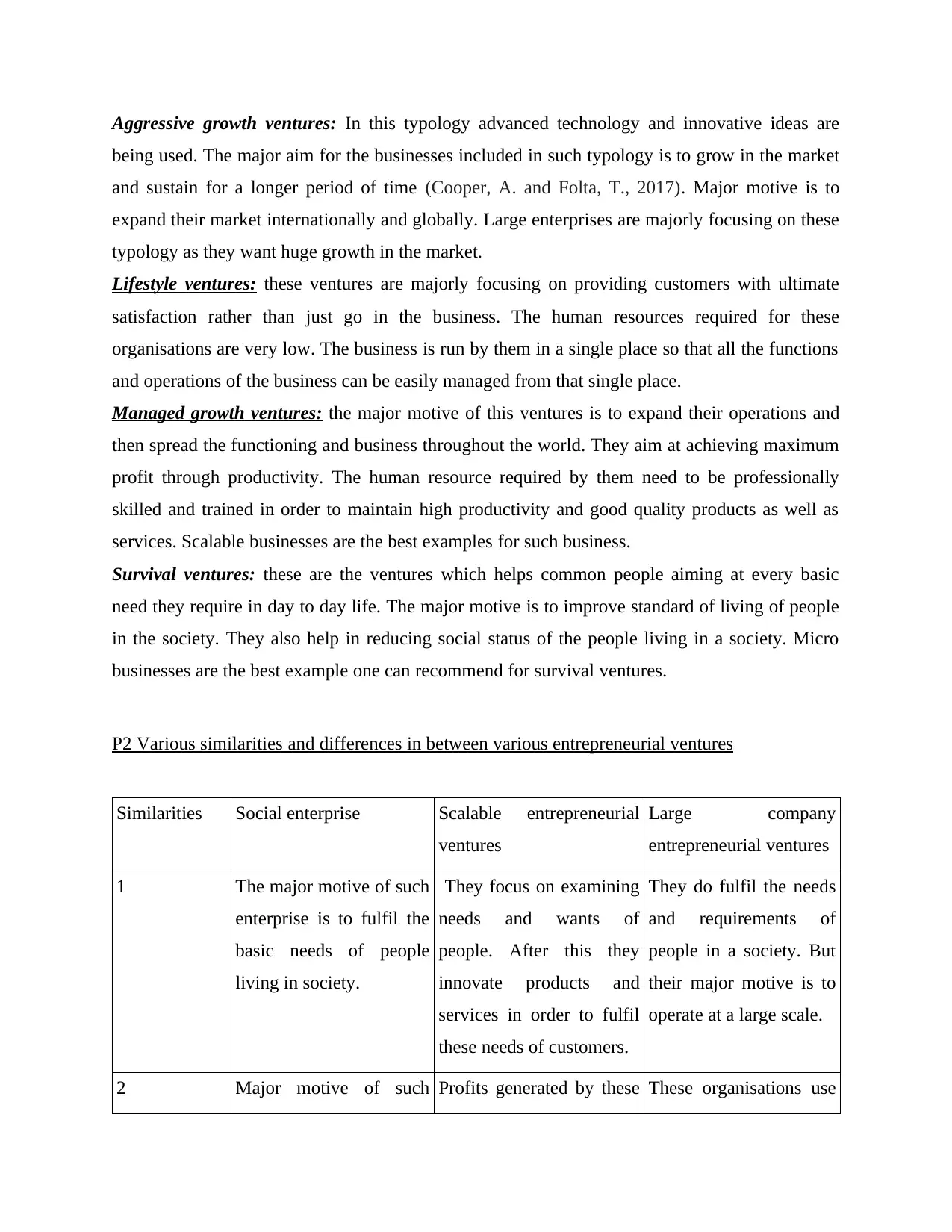
Aggressive growth ventures: In this typology advanced technology and innovative ideas are
being used. The major aim for the businesses included in such typology is to grow in the market
and sustain for a longer period of time (Cooper, A. and Folta, T., 2017). Major motive is to
expand their market internationally and globally. Large enterprises are majorly focusing on these
typology as they want huge growth in the market.
Lifestyle ventures: these ventures are majorly focusing on providing customers with ultimate
satisfaction rather than just go in the business. The human resources required for these
organisations are very low. The business is run by them in a single place so that all the functions
and operations of the business can be easily managed from that single place.
Managed growth ventures: the major motive of this ventures is to expand their operations and
then spread the functioning and business throughout the world. They aim at achieving maximum
profit through productivity. The human resource required by them need to be professionally
skilled and trained in order to maintain high productivity and good quality products as well as
services. Scalable businesses are the best examples for such business.
Survival ventures: these are the ventures which helps common people aiming at every basic
need they require in day to day life. The major motive is to improve standard of living of people
in the society. They also help in reducing social status of the people living in a society. Micro
businesses are the best example one can recommend for survival ventures.
P2 Various similarities and differences in between various entrepreneurial ventures
Similarities Social enterprise Scalable entrepreneurial
ventures
Large company
entrepreneurial ventures
1 The major motive of such
enterprise is to fulfil the
basic needs of people
living in society.
They focus on examining
needs and wants of
people. After this they
innovate products and
services in order to fulfil
these needs of customers.
They do fulfil the needs
and requirements of
people in a society. But
their major motive is to
operate at a large scale.
2 Major motive of such Profits generated by these These organisations use
being used. The major aim for the businesses included in such typology is to grow in the market
and sustain for a longer period of time (Cooper, A. and Folta, T., 2017). Major motive is to
expand their market internationally and globally. Large enterprises are majorly focusing on these
typology as they want huge growth in the market.
Lifestyle ventures: these ventures are majorly focusing on providing customers with ultimate
satisfaction rather than just go in the business. The human resources required for these
organisations are very low. The business is run by them in a single place so that all the functions
and operations of the business can be easily managed from that single place.
Managed growth ventures: the major motive of this ventures is to expand their operations and
then spread the functioning and business throughout the world. They aim at achieving maximum
profit through productivity. The human resource required by them need to be professionally
skilled and trained in order to maintain high productivity and good quality products as well as
services. Scalable businesses are the best examples for such business.
Survival ventures: these are the ventures which helps common people aiming at every basic
need they require in day to day life. The major motive is to improve standard of living of people
in the society. They also help in reducing social status of the people living in a society. Micro
businesses are the best example one can recommend for survival ventures.
P2 Various similarities and differences in between various entrepreneurial ventures
Similarities Social enterprise Scalable entrepreneurial
ventures
Large company
entrepreneurial ventures
1 The major motive of such
enterprise is to fulfil the
basic needs of people
living in society.
They focus on examining
needs and wants of
people. After this they
innovate products and
services in order to fulfil
these needs of customers.
They do fulfil the needs
and requirements of
people in a society. But
their major motive is to
operate at a large scale.
2 Major motive of such Profits generated by these These organisations use
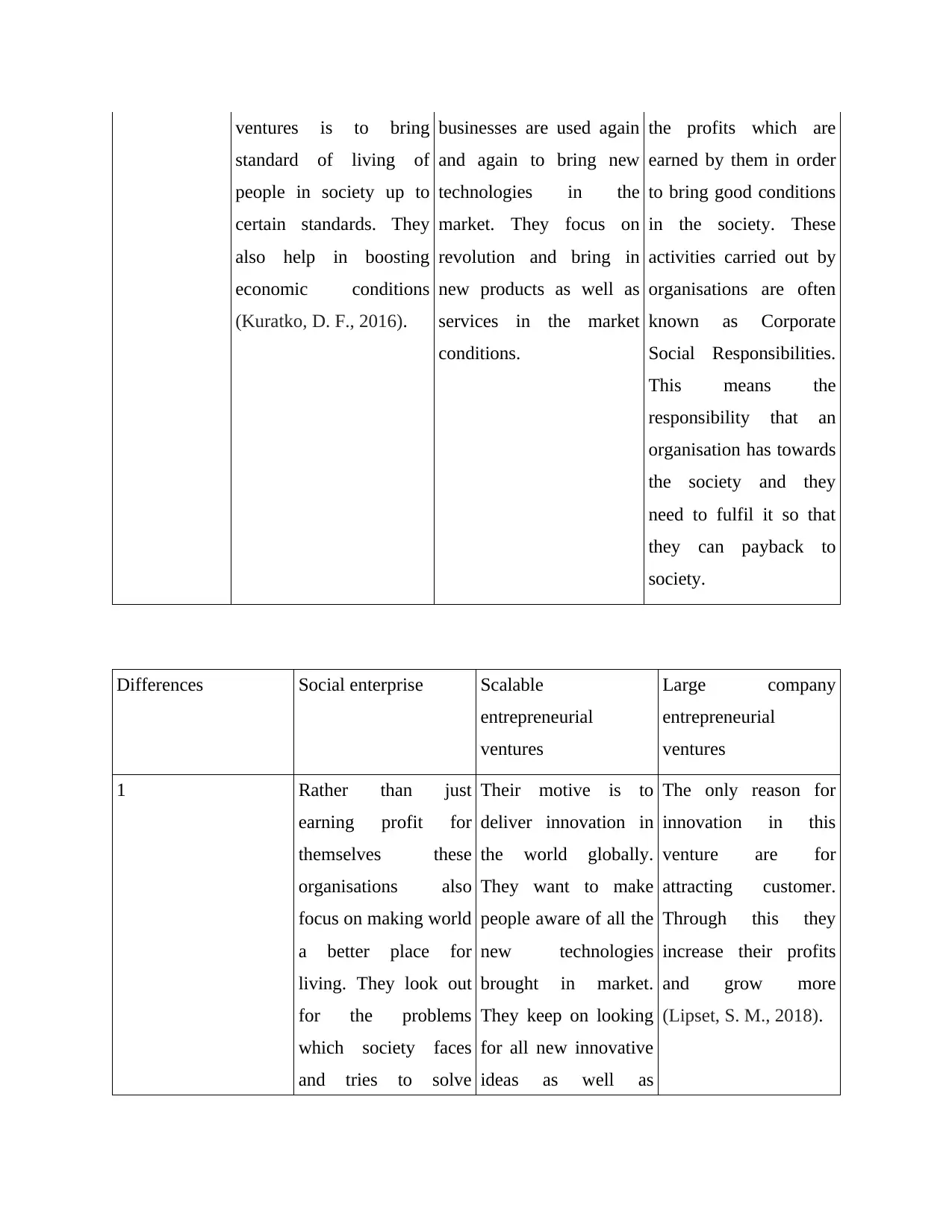
ventures is to bring
standard of living of
people in society up to
certain standards. They
also help in boosting
economic conditions
(Kuratko, D. F., 2016).
businesses are used again
and again to bring new
technologies in the
market. They focus on
revolution and bring in
new products as well as
services in the market
conditions.
the profits which are
earned by them in order
to bring good conditions
in the society. These
activities carried out by
organisations are often
known as Corporate
Social Responsibilities.
This means the
responsibility that an
organisation has towards
the society and they
need to fulfil it so that
they can payback to
society.
Differences Social enterprise Scalable
entrepreneurial
ventures
Large company
entrepreneurial
ventures
1 Rather than just
earning profit for
themselves these
organisations also
focus on making world
a better place for
living. They look out
for the problems
which society faces
and tries to solve
Their motive is to
deliver innovation in
the world globally.
They want to make
people aware of all the
new technologies
brought in market.
They keep on looking
for all new innovative
ideas as well as
The only reason for
innovation in this
venture are for
attracting customer.
Through this they
increase their profits
and grow more
(Lipset, S. M., 2018).
standard of living of
people in society up to
certain standards. They
also help in boosting
economic conditions
(Kuratko, D. F., 2016).
businesses are used again
and again to bring new
technologies in the
market. They focus on
revolution and bring in
new products as well as
services in the market
conditions.
the profits which are
earned by them in order
to bring good conditions
in the society. These
activities carried out by
organisations are often
known as Corporate
Social Responsibilities.
This means the
responsibility that an
organisation has towards
the society and they
need to fulfil it so that
they can payback to
society.
Differences Social enterprise Scalable
entrepreneurial
ventures
Large company
entrepreneurial
ventures
1 Rather than just
earning profit for
themselves these
organisations also
focus on making world
a better place for
living. They look out
for the problems
which society faces
and tries to solve
Their motive is to
deliver innovation in
the world globally.
They want to make
people aware of all the
new technologies
brought in market.
They keep on looking
for all new innovative
ideas as well as
The only reason for
innovation in this
venture are for
attracting customer.
Through this they
increase their profits
and grow more
(Lipset, S. M., 2018).
⊘ This is a preview!⊘
Do you want full access?
Subscribe today to unlock all pages.

Trusted by 1+ million students worldwide

them. investors to invest in
those ideas.
2 They do not have to
work on recruiting
human resource for
their organisation.
They get people who
join them and leave
them whenever they
want to.
The people who are
highly skilled are used
by this organisation to
fulfil their purpose.
These highly skilled
workers are of great
use for this business.
They focus on
growing worldwide.
Thus, the employees
required by them need
to be recruited from all
over the world. This
helps in effective and
efficient performance
of the organisation.
3 Hill holt Wood, Café
Direct etc. are some of
its major examples.
Facebook, Instagram,
YouTube etc. are
major examples of
such ventures.
Microsoft, Apple,
Yahoo, Samsung and
so on are major
examples for these
ventures.
TASK2
P3 Interpret relevant data on how micro and small businesses impact economy
Small businesses: These are independently owned company with a smaller number of labours.
Manufacturing companies can be taken as example for this company consisting of around 50
workers (Schaper, M. ed., 2016).
those ideas.
2 They do not have to
work on recruiting
human resource for
their organisation.
They get people who
join them and leave
them whenever they
want to.
The people who are
highly skilled are used
by this organisation to
fulfil their purpose.
These highly skilled
workers are of great
use for this business.
They focus on
growing worldwide.
Thus, the employees
required by them need
to be recruited from all
over the world. This
helps in effective and
efficient performance
of the organisation.
3 Hill holt Wood, Café
Direct etc. are some of
its major examples.
Facebook, Instagram,
YouTube etc. are
major examples of
such ventures.
Microsoft, Apple,
Yahoo, Samsung and
so on are major
examples for these
ventures.
TASK2
P3 Interpret relevant data on how micro and small businesses impact economy
Small businesses: These are independently owned company with a smaller number of labours.
Manufacturing companies can be taken as example for this company consisting of around 50
workers (Schaper, M. ed., 2016).
Paraphrase This Document
Need a fresh take? Get an instant paraphrase of this document with our AI Paraphraser
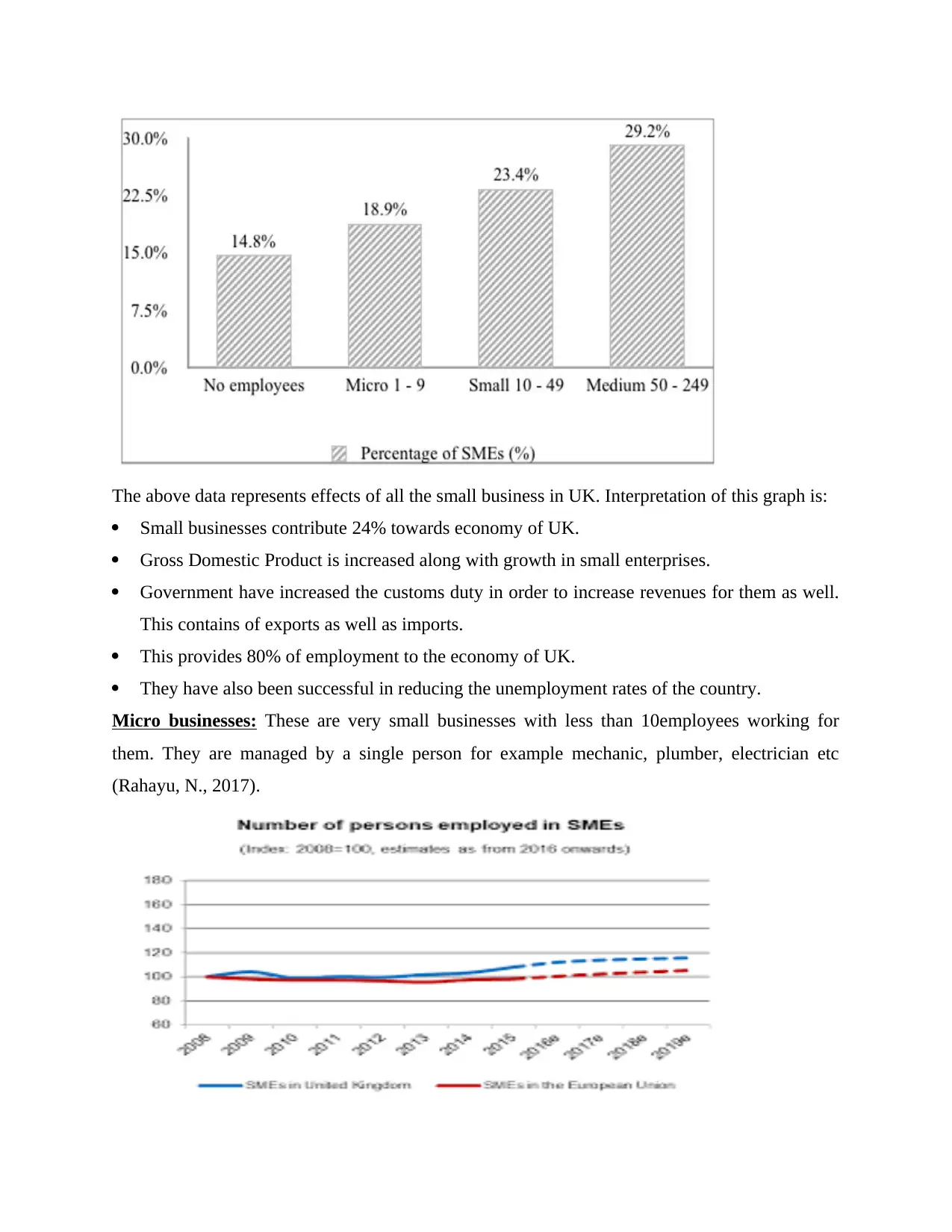
The above data represents effects of all the small business in UK. Interpretation of this graph is:
Small businesses contribute 24% towards economy of UK.
Gross Domestic Product is increased along with growth in small enterprises.
Government have increased the customs duty in order to increase revenues for them as well.
This contains of exports as well as imports.
This provides 80% of employment to the economy of UK.
They have also been successful in reducing the unemployment rates of the country.
Micro businesses: These are very small businesses with less than 10employees working for
them. They are managed by a single person for example mechanic, plumber, electrician etc
(Rahayu, N., 2017).
Small businesses contribute 24% towards economy of UK.
Gross Domestic Product is increased along with growth in small enterprises.
Government have increased the customs duty in order to increase revenues for them as well.
This contains of exports as well as imports.
This provides 80% of employment to the economy of UK.
They have also been successful in reducing the unemployment rates of the country.
Micro businesses: These are very small businesses with less than 10employees working for
them. They are managed by a single person for example mechanic, plumber, electrician etc
(Rahayu, N., 2017).
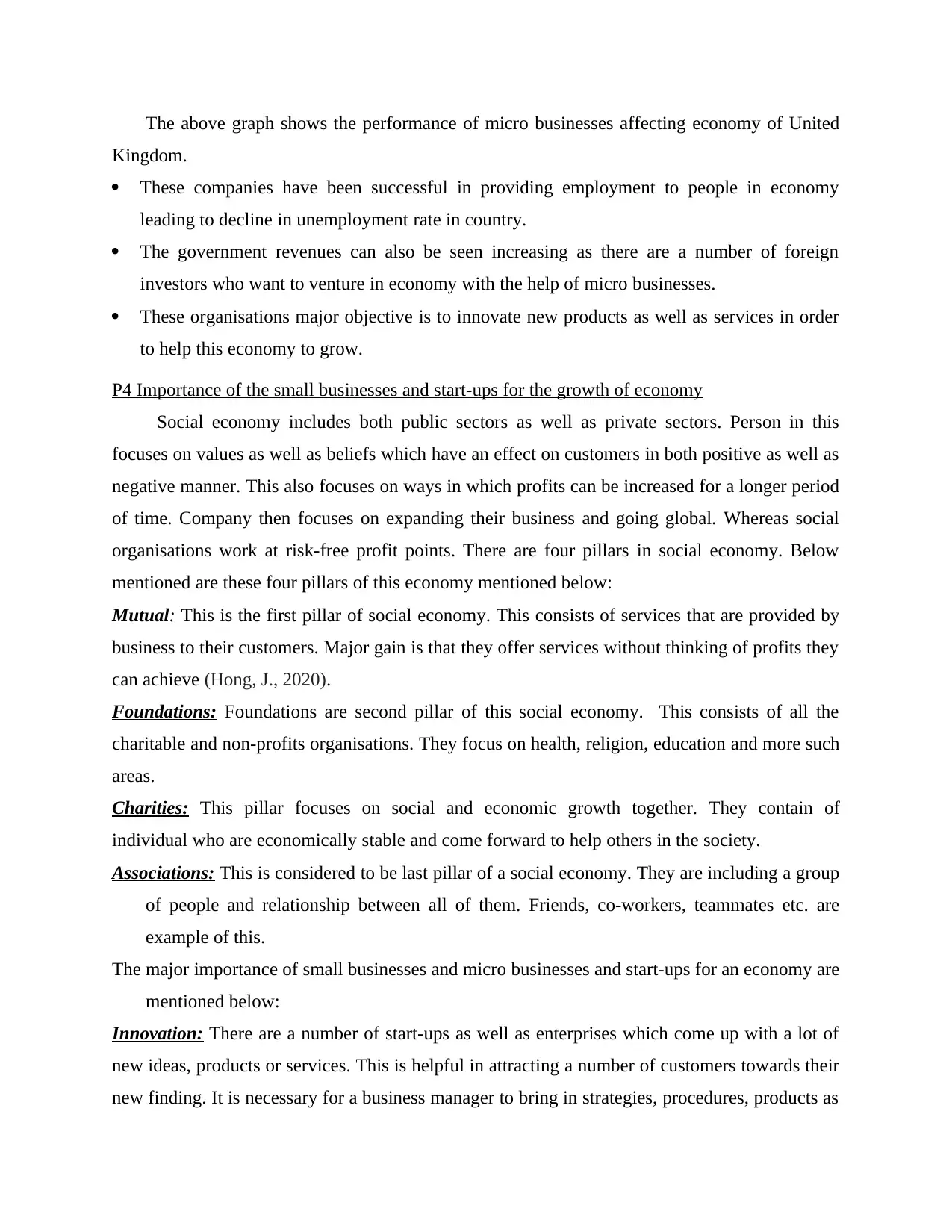
The above graph shows the performance of micro businesses affecting economy of United
Kingdom.
These companies have been successful in providing employment to people in economy
leading to decline in unemployment rate in country.
The government revenues can also be seen increasing as there are a number of foreign
investors who want to venture in economy with the help of micro businesses.
These organisations major objective is to innovate new products as well as services in order
to help this economy to grow.
P4 Importance of the small businesses and start-ups for the growth of economy
Social economy includes both public sectors as well as private sectors. Person in this
focuses on values as well as beliefs which have an effect on customers in both positive as well as
negative manner. This also focuses on ways in which profits can be increased for a longer period
of time. Company then focuses on expanding their business and going global. Whereas social
organisations work at risk-free profit points. There are four pillars in social economy. Below
mentioned are these four pillars of this economy mentioned below:
Mutual: This is the first pillar of social economy. This consists of services that are provided by
business to their customers. Major gain is that they offer services without thinking of profits they
can achieve (Hong, J., 2020).
Foundations: Foundations are second pillar of this social economy. This consists of all the
charitable and non-profits organisations. They focus on health, religion, education and more such
areas.
Charities: This pillar focuses on social and economic growth together. They contain of
individual who are economically stable and come forward to help others in the society.
Associations: This is considered to be last pillar of a social economy. They are including a group
of people and relationship between all of them. Friends, co-workers, teammates etc. are
example of this.
The major importance of small businesses and micro businesses and start-ups for an economy are
mentioned below:
Innovation: There are a number of start-ups as well as enterprises which come up with a lot of
new ideas, products or services. This is helpful in attracting a number of customers towards their
new finding. It is necessary for a business manager to bring in strategies, procedures, products as
Kingdom.
These companies have been successful in providing employment to people in economy
leading to decline in unemployment rate in country.
The government revenues can also be seen increasing as there are a number of foreign
investors who want to venture in economy with the help of micro businesses.
These organisations major objective is to innovate new products as well as services in order
to help this economy to grow.
P4 Importance of the small businesses and start-ups for the growth of economy
Social economy includes both public sectors as well as private sectors. Person in this
focuses on values as well as beliefs which have an effect on customers in both positive as well as
negative manner. This also focuses on ways in which profits can be increased for a longer period
of time. Company then focuses on expanding their business and going global. Whereas social
organisations work at risk-free profit points. There are four pillars in social economy. Below
mentioned are these four pillars of this economy mentioned below:
Mutual: This is the first pillar of social economy. This consists of services that are provided by
business to their customers. Major gain is that they offer services without thinking of profits they
can achieve (Hong, J., 2020).
Foundations: Foundations are second pillar of this social economy. This consists of all the
charitable and non-profits organisations. They focus on health, religion, education and more such
areas.
Charities: This pillar focuses on social and economic growth together. They contain of
individual who are economically stable and come forward to help others in the society.
Associations: This is considered to be last pillar of a social economy. They are including a group
of people and relationship between all of them. Friends, co-workers, teammates etc. are
example of this.
The major importance of small businesses and micro businesses and start-ups for an economy are
mentioned below:
Innovation: There are a number of start-ups as well as enterprises which come up with a lot of
new ideas, products or services. This is helpful in attracting a number of customers towards their
new finding. It is necessary for a business manager to bring in strategies, procedures, products as
⊘ This is a preview!⊘
Do you want full access?
Subscribe today to unlock all pages.

Trusted by 1+ million students worldwide
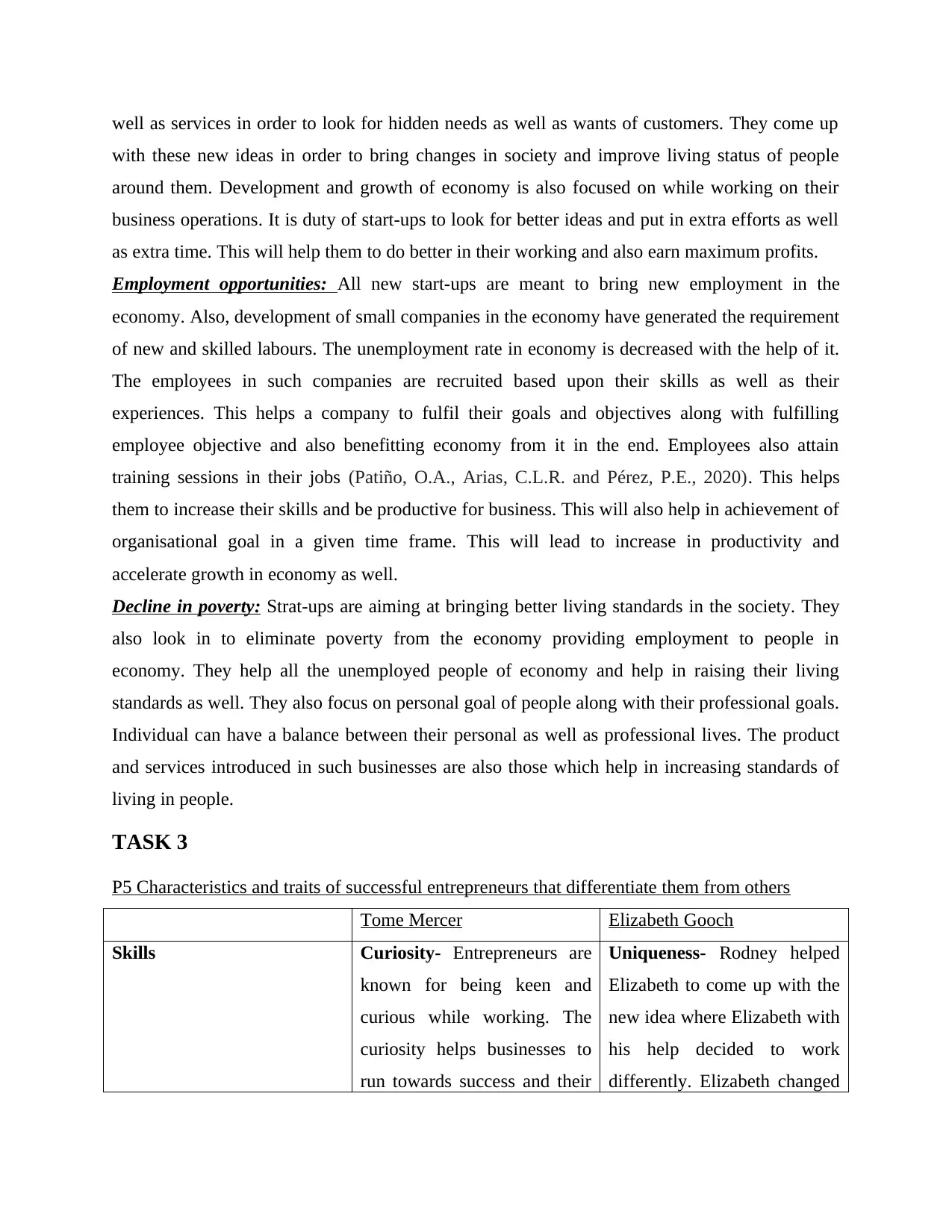
well as services in order to look for hidden needs as well as wants of customers. They come up
with these new ideas in order to bring changes in society and improve living status of people
around them. Development and growth of economy is also focused on while working on their
business operations. It is duty of start-ups to look for better ideas and put in extra efforts as well
as extra time. This will help them to do better in their working and also earn maximum profits.
Employment opportunities: All new start-ups are meant to bring new employment in the
economy. Also, development of small companies in the economy have generated the requirement
of new and skilled labours. The unemployment rate in economy is decreased with the help of it.
The employees in such companies are recruited based upon their skills as well as their
experiences. This helps a company to fulfil their goals and objectives along with fulfilling
employee objective and also benefitting economy from it in the end. Employees also attain
training sessions in their jobs (Patiño, O.A., Arias, C.L.R. and Pérez, P.E., 2020). This helps
them to increase their skills and be productive for business. This will also help in achievement of
organisational goal in a given time frame. This will lead to increase in productivity and
accelerate growth in economy as well.
Decline in poverty: Strat-ups are aiming at bringing better living standards in the society. They
also look in to eliminate poverty from the economy providing employment to people in
economy. They help all the unemployed people of economy and help in raising their living
standards as well. They also focus on personal goal of people along with their professional goals.
Individual can have a balance between their personal as well as professional lives. The product
and services introduced in such businesses are also those which help in increasing standards of
living in people.
TASK 3
P5 Characteristics and traits of successful entrepreneurs that differentiate them from others
Tome Mercer Elizabeth Gooch
Skills Curiosity- Entrepreneurs are
known for being keen and
curious while working. The
curiosity helps businesses to
run towards success and their
Uniqueness- Rodney helped
Elizabeth to come up with the
new idea where Elizabeth with
his help decided to work
differently. Elizabeth changed
with these new ideas in order to bring changes in society and improve living status of people
around them. Development and growth of economy is also focused on while working on their
business operations. It is duty of start-ups to look for better ideas and put in extra efforts as well
as extra time. This will help them to do better in their working and also earn maximum profits.
Employment opportunities: All new start-ups are meant to bring new employment in the
economy. Also, development of small companies in the economy have generated the requirement
of new and skilled labours. The unemployment rate in economy is decreased with the help of it.
The employees in such companies are recruited based upon their skills as well as their
experiences. This helps a company to fulfil their goals and objectives along with fulfilling
employee objective and also benefitting economy from it in the end. Employees also attain
training sessions in their jobs (Patiño, O.A., Arias, C.L.R. and Pérez, P.E., 2020). This helps
them to increase their skills and be productive for business. This will also help in achievement of
organisational goal in a given time frame. This will lead to increase in productivity and
accelerate growth in economy as well.
Decline in poverty: Strat-ups are aiming at bringing better living standards in the society. They
also look in to eliminate poverty from the economy providing employment to people in
economy. They help all the unemployed people of economy and help in raising their living
standards as well. They also focus on personal goal of people along with their professional goals.
Individual can have a balance between their personal as well as professional lives. The product
and services introduced in such businesses are also those which help in increasing standards of
living in people.
TASK 3
P5 Characteristics and traits of successful entrepreneurs that differentiate them from others
Tome Mercer Elizabeth Gooch
Skills Curiosity- Entrepreneurs are
known for being keen and
curious while working. The
curiosity helps businesses to
run towards success and their
Uniqueness- Rodney helped
Elizabeth to come up with the
new idea where Elizabeth with
his help decided to work
differently. Elizabeth changed
Paraphrase This Document
Need a fresh take? Get an instant paraphrase of this document with our AI Paraphraser
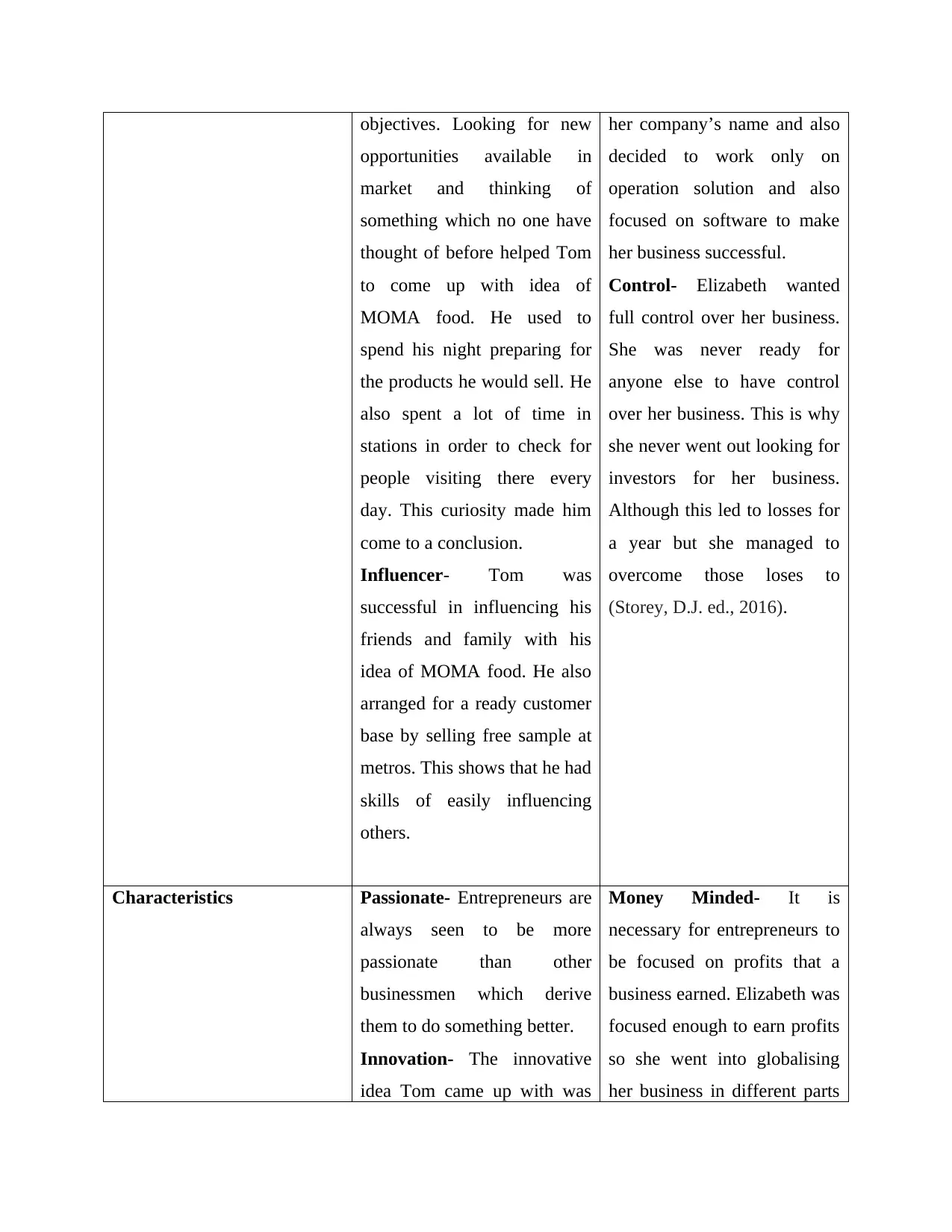
objectives. Looking for new
opportunities available in
market and thinking of
something which no one have
thought of before helped Tom
to come up with idea of
MOMA food. He used to
spend his night preparing for
the products he would sell. He
also spent a lot of time in
stations in order to check for
people visiting there every
day. This curiosity made him
come to a conclusion.
Influencer- Tom was
successful in influencing his
friends and family with his
idea of MOMA food. He also
arranged for a ready customer
base by selling free sample at
metros. This shows that he had
skills of easily influencing
others.
her company’s name and also
decided to work only on
operation solution and also
focused on software to make
her business successful.
Control- Elizabeth wanted
full control over her business.
She was never ready for
anyone else to have control
over her business. This is why
she never went out looking for
investors for her business.
Although this led to losses for
a year but she managed to
overcome those loses to
(Storey, D.J. ed., 2016).
Characteristics Passionate- Entrepreneurs are
always seen to be more
passionate than other
businessmen which derive
them to do something better.
Innovation- The innovative
idea Tom came up with was
Money Minded- It is
necessary for entrepreneurs to
be focused on profits that a
business earned. Elizabeth was
focused enough to earn profits
so she went into globalising
her business in different parts
opportunities available in
market and thinking of
something which no one have
thought of before helped Tom
to come up with idea of
MOMA food. He used to
spend his night preparing for
the products he would sell. He
also spent a lot of time in
stations in order to check for
people visiting there every
day. This curiosity made him
come to a conclusion.
Influencer- Tom was
successful in influencing his
friends and family with his
idea of MOMA food. He also
arranged for a ready customer
base by selling free sample at
metros. This shows that he had
skills of easily influencing
others.
her company’s name and also
decided to work only on
operation solution and also
focused on software to make
her business successful.
Control- Elizabeth wanted
full control over her business.
She was never ready for
anyone else to have control
over her business. This is why
she never went out looking for
investors for her business.
Although this led to losses for
a year but she managed to
overcome those loses to
(Storey, D.J. ed., 2016).
Characteristics Passionate- Entrepreneurs are
always seen to be more
passionate than other
businessmen which derive
them to do something better.
Innovation- The innovative
idea Tom came up with was
Money Minded- It is
necessary for entrepreneurs to
be focused on profits that a
business earned. Elizabeth was
focused enough to earn profits
so she went into globalising
her business in different parts
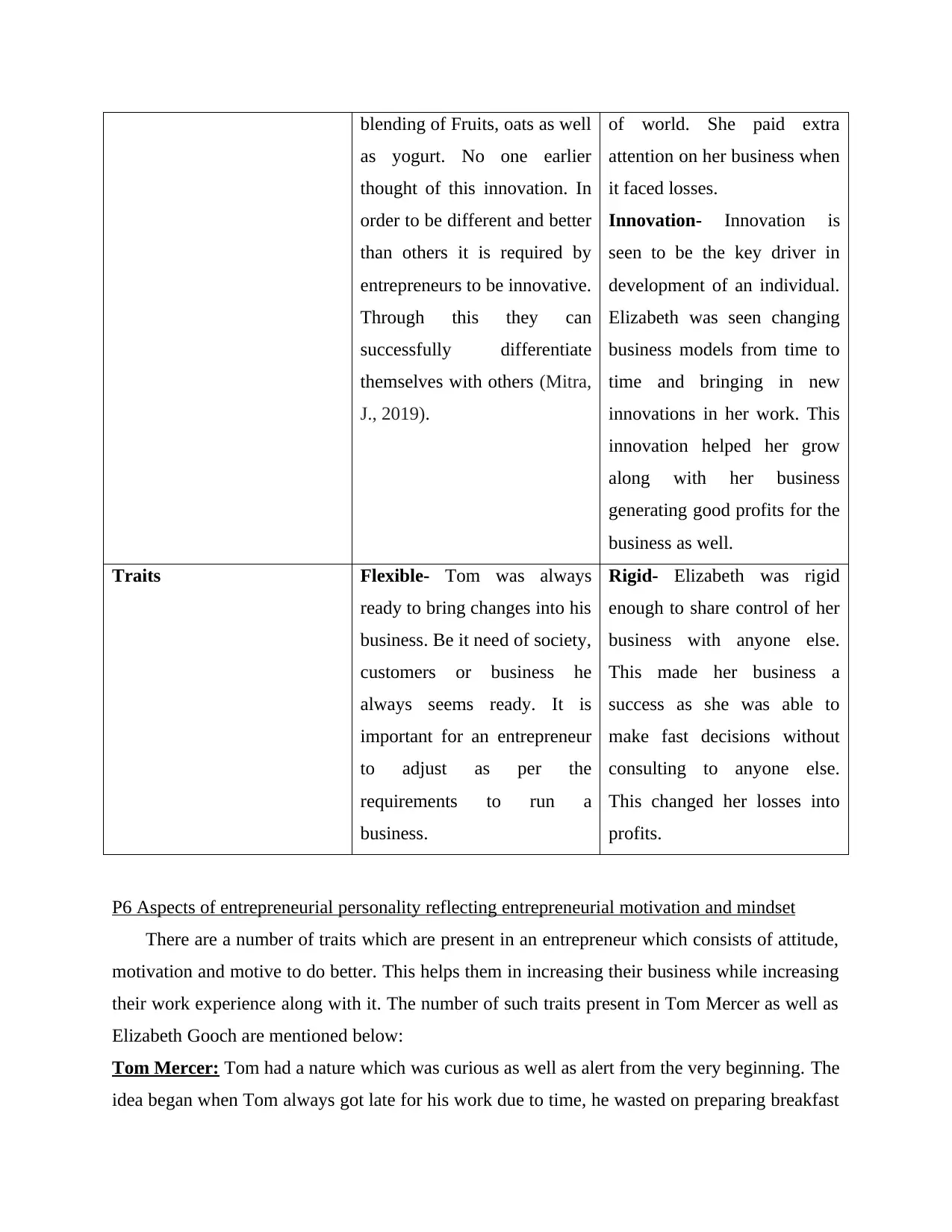
blending of Fruits, oats as well
as yogurt. No one earlier
thought of this innovation. In
order to be different and better
than others it is required by
entrepreneurs to be innovative.
Through this they can
successfully differentiate
themselves with others (Mitra,
J., 2019).
of world. She paid extra
attention on her business when
it faced losses.
Innovation- Innovation is
seen to be the key driver in
development of an individual.
Elizabeth was seen changing
business models from time to
time and bringing in new
innovations in her work. This
innovation helped her grow
along with her business
generating good profits for the
business as well.
Traits Flexible- Tom was always
ready to bring changes into his
business. Be it need of society,
customers or business he
always seems ready. It is
important for an entrepreneur
to adjust as per the
requirements to run a
business.
Rigid- Elizabeth was rigid
enough to share control of her
business with anyone else.
This made her business a
success as she was able to
make fast decisions without
consulting to anyone else.
This changed her losses into
profits.
P6 Aspects of entrepreneurial personality reflecting entrepreneurial motivation and mindset
There are a number of traits which are present in an entrepreneur which consists of attitude,
motivation and motive to do better. This helps them in increasing their business while increasing
their work experience along with it. The number of such traits present in Tom Mercer as well as
Elizabeth Gooch are mentioned below:
Tom Mercer: Tom had a nature which was curious as well as alert from the very beginning. The
idea began when Tom always got late for his work due to time, he wasted on preparing breakfast
as yogurt. No one earlier
thought of this innovation. In
order to be different and better
than others it is required by
entrepreneurs to be innovative.
Through this they can
successfully differentiate
themselves with others (Mitra,
J., 2019).
of world. She paid extra
attention on her business when
it faced losses.
Innovation- Innovation is
seen to be the key driver in
development of an individual.
Elizabeth was seen changing
business models from time to
time and bringing in new
innovations in her work. This
innovation helped her grow
along with her business
generating good profits for the
business as well.
Traits Flexible- Tom was always
ready to bring changes into his
business. Be it need of society,
customers or business he
always seems ready. It is
important for an entrepreneur
to adjust as per the
requirements to run a
business.
Rigid- Elizabeth was rigid
enough to share control of her
business with anyone else.
This made her business a
success as she was able to
make fast decisions without
consulting to anyone else.
This changed her losses into
profits.
P6 Aspects of entrepreneurial personality reflecting entrepreneurial motivation and mindset
There are a number of traits which are present in an entrepreneur which consists of attitude,
motivation and motive to do better. This helps them in increasing their business while increasing
their work experience along with it. The number of such traits present in Tom Mercer as well as
Elizabeth Gooch are mentioned below:
Tom Mercer: Tom had a nature which was curious as well as alert from the very beginning. The
idea began when Tom always got late for his work due to time, he wasted on preparing breakfast
⊘ This is a preview!⊘
Do you want full access?
Subscribe today to unlock all pages.

Trusted by 1+ million students worldwide
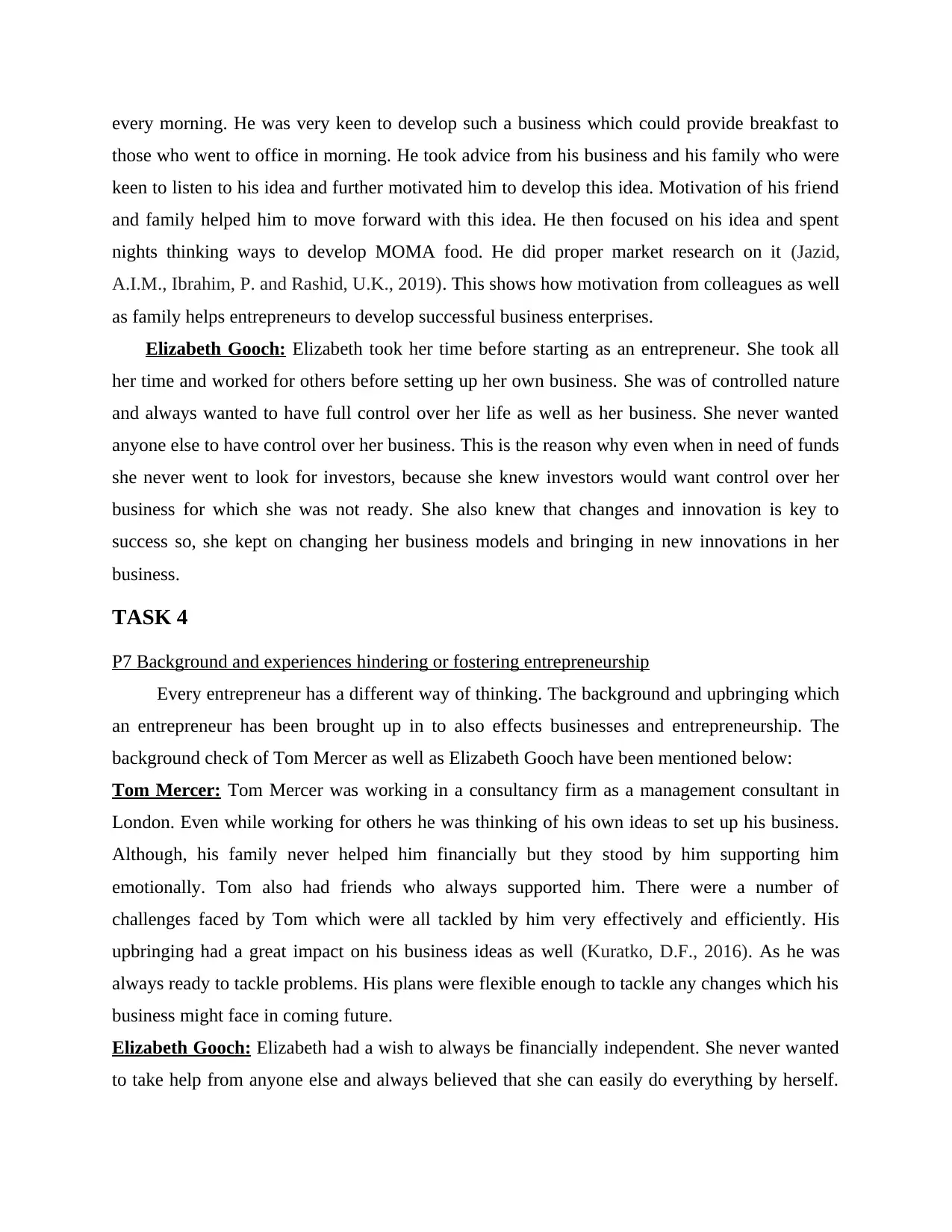
every morning. He was very keen to develop such a business which could provide breakfast to
those who went to office in morning. He took advice from his business and his family who were
keen to listen to his idea and further motivated him to develop this idea. Motivation of his friend
and family helped him to move forward with this idea. He then focused on his idea and spent
nights thinking ways to develop MOMA food. He did proper market research on it (Jazid,
A.I.M., Ibrahim, P. and Rashid, U.K., 2019). This shows how motivation from colleagues as well
as family helps entrepreneurs to develop successful business enterprises.
Elizabeth Gooch: Elizabeth took her time before starting as an entrepreneur. She took all
her time and worked for others before setting up her own business. She was of controlled nature
and always wanted to have full control over her life as well as her business. She never wanted
anyone else to have control over her business. This is the reason why even when in need of funds
she never went to look for investors, because she knew investors would want control over her
business for which she was not ready. She also knew that changes and innovation is key to
success so, she kept on changing her business models and bringing in new innovations in her
business.
TASK 4
P7 Background and experiences hindering or fostering entrepreneurship
Every entrepreneur has a different way of thinking. The background and upbringing which
an entrepreneur has been brought up in to also effects businesses and entrepreneurship. The
background check of Tom Mercer as well as Elizabeth Gooch have been mentioned below:
Tom Mercer: Tom Mercer was working in a consultancy firm as a management consultant in
London. Even while working for others he was thinking of his own ideas to set up his business.
Although, his family never helped him financially but they stood by him supporting him
emotionally. Tom also had friends who always supported him. There were a number of
challenges faced by Tom which were all tackled by him very effectively and efficiently. His
upbringing had a great impact on his business ideas as well (Kuratko, D.F., 2016). As he was
always ready to tackle problems. His plans were flexible enough to tackle any changes which his
business might face in coming future.
Elizabeth Gooch: Elizabeth had a wish to always be financially independent. She never wanted
to take help from anyone else and always believed that she can easily do everything by herself.
those who went to office in morning. He took advice from his business and his family who were
keen to listen to his idea and further motivated him to develop this idea. Motivation of his friend
and family helped him to move forward with this idea. He then focused on his idea and spent
nights thinking ways to develop MOMA food. He did proper market research on it (Jazid,
A.I.M., Ibrahim, P. and Rashid, U.K., 2019). This shows how motivation from colleagues as well
as family helps entrepreneurs to develop successful business enterprises.
Elizabeth Gooch: Elizabeth took her time before starting as an entrepreneur. She took all
her time and worked for others before setting up her own business. She was of controlled nature
and always wanted to have full control over her life as well as her business. She never wanted
anyone else to have control over her business. This is the reason why even when in need of funds
she never went to look for investors, because she knew investors would want control over her
business for which she was not ready. She also knew that changes and innovation is key to
success so, she kept on changing her business models and bringing in new innovations in her
business.
TASK 4
P7 Background and experiences hindering or fostering entrepreneurship
Every entrepreneur has a different way of thinking. The background and upbringing which
an entrepreneur has been brought up in to also effects businesses and entrepreneurship. The
background check of Tom Mercer as well as Elizabeth Gooch have been mentioned below:
Tom Mercer: Tom Mercer was working in a consultancy firm as a management consultant in
London. Even while working for others he was thinking of his own ideas to set up his business.
Although, his family never helped him financially but they stood by him supporting him
emotionally. Tom also had friends who always supported him. There were a number of
challenges faced by Tom which were all tackled by him very effectively and efficiently. His
upbringing had a great impact on his business ideas as well (Kuratko, D.F., 2016). As he was
always ready to tackle problems. His plans were flexible enough to tackle any changes which his
business might face in coming future.
Elizabeth Gooch: Elizabeth had a wish to always be financially independent. She never wanted
to take help from anyone else and always believed that she can easily do everything by herself.
Paraphrase This Document
Need a fresh take? Get an instant paraphrase of this document with our AI Paraphraser
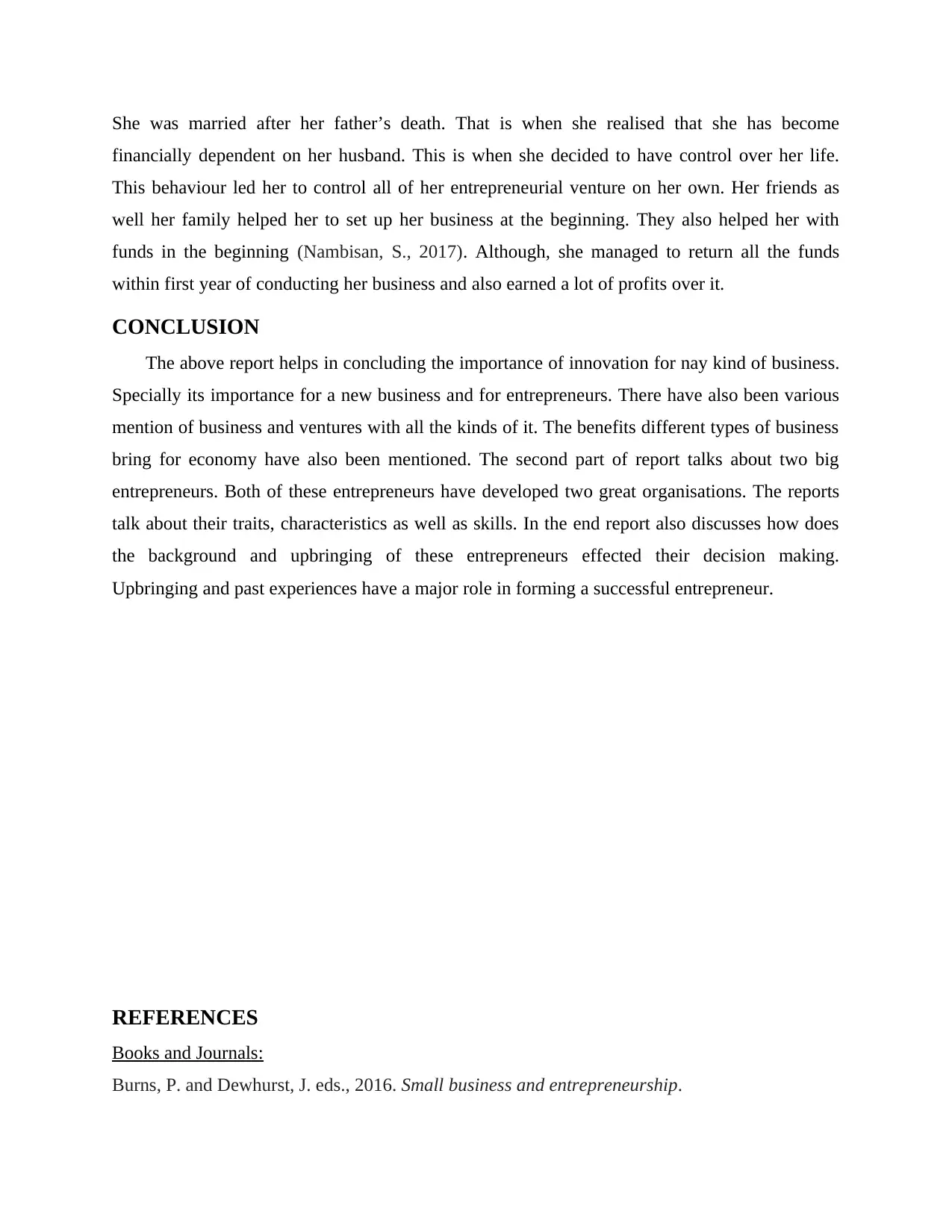
She was married after her father’s death. That is when she realised that she has become
financially dependent on her husband. This is when she decided to have control over her life.
This behaviour led her to control all of her entrepreneurial venture on her own. Her friends as
well her family helped her to set up her business at the beginning. They also helped her with
funds in the beginning (Nambisan, S., 2017). Although, she managed to return all the funds
within first year of conducting her business and also earned a lot of profits over it.
CONCLUSION
The above report helps in concluding the importance of innovation for nay kind of business.
Specially its importance for a new business and for entrepreneurs. There have also been various
mention of business and ventures with all the kinds of it. The benefits different types of business
bring for economy have also been mentioned. The second part of report talks about two big
entrepreneurs. Both of these entrepreneurs have developed two great organisations. The reports
talk about their traits, characteristics as well as skills. In the end report also discusses how does
the background and upbringing of these entrepreneurs effected their decision making.
Upbringing and past experiences have a major role in forming a successful entrepreneur.
REFERENCES
Books and Journals:
Burns, P. and Dewhurst, J. eds., 2016. Small business and entrepreneurship.
financially dependent on her husband. This is when she decided to have control over her life.
This behaviour led her to control all of her entrepreneurial venture on her own. Her friends as
well her family helped her to set up her business at the beginning. They also helped her with
funds in the beginning (Nambisan, S., 2017). Although, she managed to return all the funds
within first year of conducting her business and also earned a lot of profits over it.
CONCLUSION
The above report helps in concluding the importance of innovation for nay kind of business.
Specially its importance for a new business and for entrepreneurs. There have also been various
mention of business and ventures with all the kinds of it. The benefits different types of business
bring for economy have also been mentioned. The second part of report talks about two big
entrepreneurs. Both of these entrepreneurs have developed two great organisations. The reports
talk about their traits, characteristics as well as skills. In the end report also discusses how does
the background and upbringing of these entrepreneurs effected their decision making.
Upbringing and past experiences have a major role in forming a successful entrepreneur.
REFERENCES
Books and Journals:
Burns, P. and Dewhurst, J. eds., 2016. Small business and entrepreneurship.
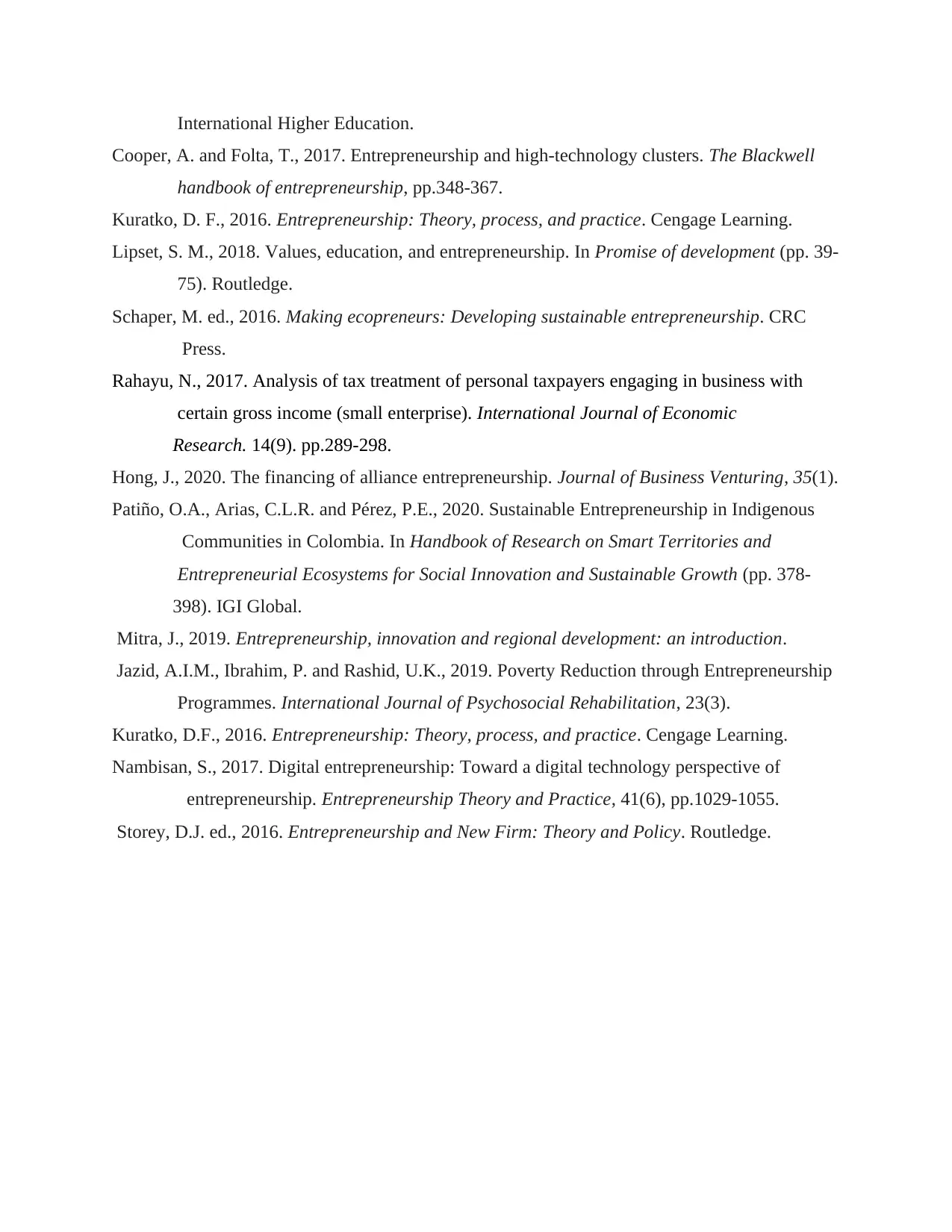
International Higher Education.
Cooper, A. and Folta, T., 2017. Entrepreneurship and high‐technology clusters. The Blackwell
handbook of entrepreneurship, pp.348-367.
Kuratko, D. F., 2016. Entrepreneurship: Theory, process, and practice. Cengage Learning.
Lipset, S. M., 2018. Values, education, and entrepreneurship. In Promise of development (pp. 39-
75). Routledge.
Schaper, M. ed., 2016. Making ecopreneurs: Developing sustainable entrepreneurship. CRC
Press.
Rahayu, N., 2017. Analysis of tax treatment of personal taxpayers engaging in business with
certain gross income (small enterprise). International Journal of Economic
Research. 14(9). pp.289-298.
Hong, J., 2020. The financing of alliance entrepreneurship. Journal of Business Venturing, 35(1).
Patiño, O.A., Arias, C.L.R. and Pérez, P.E., 2020. Sustainable Entrepreneurship in Indigenous
Communities in Colombia. In Handbook of Research on Smart Territories and
Entrepreneurial Ecosystems for Social Innovation and Sustainable Growth (pp. 378-
398). IGI Global.
Mitra, J., 2019. Entrepreneurship, innovation and regional development: an introduction.
Jazid, A.I.M., Ibrahim, P. and Rashid, U.K., 2019. Poverty Reduction through Entrepreneurship
Programmes. International Journal of Psychosocial Rehabilitation, 23(3).
Kuratko, D.F., 2016. Entrepreneurship: Theory, process, and practice. Cengage Learning.
Nambisan, S., 2017. Digital entrepreneurship: Toward a digital technology perspective of
entrepreneurship. Entrepreneurship Theory and Practice, 41(6), pp.1029-1055.
Storey, D.J. ed., 2016. Entrepreneurship and New Firm: Theory and Policy. Routledge.
Cooper, A. and Folta, T., 2017. Entrepreneurship and high‐technology clusters. The Blackwell
handbook of entrepreneurship, pp.348-367.
Kuratko, D. F., 2016. Entrepreneurship: Theory, process, and practice. Cengage Learning.
Lipset, S. M., 2018. Values, education, and entrepreneurship. In Promise of development (pp. 39-
75). Routledge.
Schaper, M. ed., 2016. Making ecopreneurs: Developing sustainable entrepreneurship. CRC
Press.
Rahayu, N., 2017. Analysis of tax treatment of personal taxpayers engaging in business with
certain gross income (small enterprise). International Journal of Economic
Research. 14(9). pp.289-298.
Hong, J., 2020. The financing of alliance entrepreneurship. Journal of Business Venturing, 35(1).
Patiño, O.A., Arias, C.L.R. and Pérez, P.E., 2020. Sustainable Entrepreneurship in Indigenous
Communities in Colombia. In Handbook of Research on Smart Territories and
Entrepreneurial Ecosystems for Social Innovation and Sustainable Growth (pp. 378-
398). IGI Global.
Mitra, J., 2019. Entrepreneurship, innovation and regional development: an introduction.
Jazid, A.I.M., Ibrahim, P. and Rashid, U.K., 2019. Poverty Reduction through Entrepreneurship
Programmes. International Journal of Psychosocial Rehabilitation, 23(3).
Kuratko, D.F., 2016. Entrepreneurship: Theory, process, and practice. Cengage Learning.
Nambisan, S., 2017. Digital entrepreneurship: Toward a digital technology perspective of
entrepreneurship. Entrepreneurship Theory and Practice, 41(6), pp.1029-1055.
Storey, D.J. ed., 2016. Entrepreneurship and New Firm: Theory and Policy. Routledge.
⊘ This is a preview!⊘
Do you want full access?
Subscribe today to unlock all pages.

Trusted by 1+ million students worldwide
1 out of 15
Related Documents
Your All-in-One AI-Powered Toolkit for Academic Success.
+13062052269
info@desklib.com
Available 24*7 on WhatsApp / Email
![[object Object]](/_next/static/media/star-bottom.7253800d.svg)
Unlock your academic potential
© 2024 | Zucol Services PVT LTD | All rights reserved.





